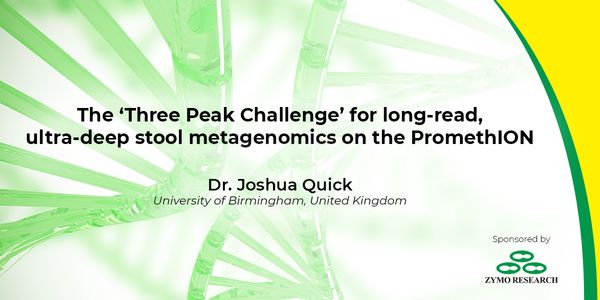Ecology
Ecology: the scientific analysis and study of interactions among organisms and their environment. Ecology includes the study of interactions that organisms have with each other, other organisms, and with abiotic components of their environment. Topics of interest to ecologists include the diversity, distribution, amount (biomass), and number (population) of particular organisms, as well as cooperation and competition between organisms, both within and among ecosystems.
-
NOV 06, 2019 | 6:00 AMMultiple factors can affect and impact infection dynamics and virulence produced by influenza virus (IV) infections. Susceptibility factors and host responses can also have major effects in d...OCT 15, 2019 | 10:00 AMDATE: October 15, 2019TIME: 10:00am PDTAdvances in Next-Generation Sequencing technologies as well as bioinformatic tools have advanced our ability to research and explore both human...OCT 03, 2019 | 6:00 AMInsects are the largest and most diverse arthropod group. Many insect species are agricultural pests or vectors of numerous diseases. In fact, the mosquito is the deadliest animal on the eart...SEP 12, 2019 | 9:00 AMPlants recruit soil microbes that provide nutrients, promote growth and protect against pathogens. However, the full potential of microbial communities for supporting plant health and agricul...FEB 05, 2019 | 9:00 AMDATE: February 5, 2019TIME: 9:00am PST, 12:00pm EST CloudLIMS.com is pleased to invite you to attend a complimentary webinar. The webinar focuses on the importa...SEP 14, 2017 | 1:30 PMPlant viruses cause significant damage in terms of reduction in quality and quantity of yield in a wide range of crop plants worldwide. The majority of plant viruses are transmitted from one...SEP 13, 2017 | 10:30 AMRob Dunn has recently published Never Out of Season, the story of the homogenization of our global food supply and the risks that homogenization poses. He will build on the stories from this...SEP 13, 2017 | 7:30 AMIncreasing prevalence and severity of multi-drug-resistant (MDR) bacterial infections has necessitated novel antibacterial strategies. Ideally, new approaches would target bacterial pat...FEB 20, 2017 | 8:00 AMSPR technology is being improved steadily and today is an essential component in the biopharmaceutical industry. As SPR based assays extract valuable and reliable information at high accuracy...SEP 08, 2016 | 12:00 PMVirus Ecology is a field that is gaining momentum, fueled in part by metagenomic studies from many environments previously ignored. Biodiversity studies of plant viruses show that they...SEP 08, 2016 | 12:00 PMThis presentation will be demonstrating several different approaches to explore the diversity, function, and ecology of microbial communities. In Metagenomics, the sequencing of DNA dir...SEP 07, 2016 | 1:30 PMIt is well accepted that microorganisms can exist as self-organized communities attached to surfaces and one another (i.e., biofilm), often surrounded by extracellular polymeric substances (E...SEP 07, 2016 | 6:00 AMThe human race, like all macrobiological life, evolved in a sea of microbes. There was no way to keep the bacterial and archaeal hoards at bay, so instead life evolved mechanisms to live with...MAY 12, 2016 | 10:30 AMDNA methylation is an essential mechanism of epigenetic gene regulation with broad relevance in development and disease. Its localization on genomic DNA and general stability make this epigen...APR 06, 2016 | 10:30 AMMicrobiome discovery efforts are underway in multiple disease areas. Challenges exist in sample collection, processing, assay selection and bioinformatics. Therefore heterogeneity...SEP 03, 2015 | 1:30 PMNatural preservation is often cited as effective and “safe” alternative to traditional synthetic preservative systems. However, the so-called natural preservatives bring a number...SEP 02, 2015 | 10:30 AMAdvances in sequencing technology and increasing recognition of the importance of our microbial world have led to unprecedented discoveries in recent years with respect to the human microbiom...SEP 02, 2015 | 9:00 AMThe human race, like all macrobiological life, evolved in a sea of microbes. There was no way to keep the bacterial and archaeal hoards at bay, so instead life evolved mechanisms to live with...SEP 02, 2015 | 6:00 AMAmong many surprising insights, the genomic revolution has helped us to realize that we're never alone and, in fact, barely human. For most of our lives, we share our bodies with some ten ti...FEB 06, 2014 | 7:00 AMC.E. CREDITSThe question of pain in fish has been subject to much debate and, since fish are a popular experimental model globally and commercially important in fisheries, recreational angling and aquac...
NOV 06, 2019 | 6:00 AM
Multiple factors can affect and impact infection dynamics and virulence produced by influenza virus (IV) infections. Susceptibility factors and host responses can also have major effects in d...
OCT 15, 2019 | 10:00 AM
DATE: October 15, 2019TIME: 10:00am PDTAdvances in Next-Generation Sequencing technologies as well as bioinformatic tools have advanced our ability to research and explore both human...
OCT 03, 2019 | 6:00 AM
Insects are the largest and most diverse arthropod group. Many insect species are agricultural pests or vectors of numerous diseases. In fact, the mosquito is the deadliest animal on the eart...
SEP 12, 2019 | 9:00 AM
Plants recruit soil microbes that provide nutrients, promote growth and protect against pathogens. However, the full potential of microbial communities for supporting plant health and agricul...
FEB 05, 2019 | 9:00 AM
DATE: February 5, 2019TIME: 9:00am PST, 12:00pm EST CloudLIMS.com is pleased to invite you to attend a complimentary webinar. The webinar focuses on the importa...
SEP 14, 2017 | 1:30 PM
Plant viruses cause significant damage in terms of reduction in quality and quantity of yield in a wide range of crop plants worldwide. The majority of plant viruses are transmitted from one...
SEP 13, 2017 | 10:30 AM
Rob Dunn has recently published Never Out of Season, the story of the homogenization of our global food supply and the risks that homogenization poses. He will build on the stories from this...
SEP 13, 2017 | 7:30 AM
Increasing prevalence and severity of multi-drug-resistant (MDR) bacterial infections has necessitated novel antibacterial strategies. Ideally, new approaches would target bacterial pat...
FEB 20, 2017 | 8:00 AM
SPR technology is being improved steadily and today is an essential component in the biopharmaceutical industry. As SPR based assays extract valuable and reliable information at high accuracy...
SEP 08, 2016 | 12:00 PM
Virus Ecology is a field that is gaining momentum, fueled in part by metagenomic studies from many environments previously ignored. Biodiversity studies of plant viruses show that they...
SEP 08, 2016 | 12:00 PM
This presentation will be demonstrating several different approaches to explore the diversity, function, and ecology of microbial communities. In Metagenomics, the sequencing of DNA dir...
SEP 07, 2016 | 1:30 PM
It is well accepted that microorganisms can exist as self-organized communities attached to surfaces and one another (i.e., biofilm), often surrounded by extracellular polymeric substances (E...
SEP 07, 2016 | 6:00 AM
The human race, like all macrobiological life, evolved in a sea of microbes. There was no way to keep the bacterial and archaeal hoards at bay, so instead life evolved mechanisms to live with...
MAY 12, 2016 | 10:30 AM
DNA methylation is an essential mechanism of epigenetic gene regulation with broad relevance in development and disease. Its localization on genomic DNA and general stability make this epigen...
APR 06, 2016 | 10:30 AM
Microbiome discovery efforts are underway in multiple disease areas. Challenges exist in sample collection, processing, assay selection and bioinformatics. Therefore heterogeneity...
SEP 03, 2015 | 1:30 PM
Natural preservation is often cited as effective and “safe” alternative to traditional synthetic preservative systems. However, the so-called natural preservatives bring a number...
SEP 02, 2015 | 10:30 AM
Advances in sequencing technology and increasing recognition of the importance of our microbial world have led to unprecedented discoveries in recent years with respect to the human microbiom...
SEP 02, 2015 | 9:00 AM
The human race, like all macrobiological life, evolved in a sea of microbes. There was no way to keep the bacterial and archaeal hoards at bay, so instead life evolved mechanisms to live with...
SEP 02, 2015 | 6:00 AM
Among many surprising insights, the genomic revolution has helped us to realize that we're never alone and, in fact, barely human. For most of our lives, we share our bodies with some ten ti...
FEB 06, 2014 | 7:00 AM
C.E. CREDITS
The question of pain in fish has been subject to much debate and, since fish are a popular experimental model globally and commercially important in fisheries, recreational angling and aquac...




















